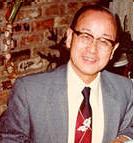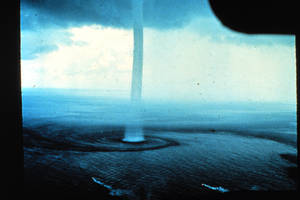This Week in Science History - Mr Tornado
Interview with
This week in Science History saw on October 23rd 1920, the birth of Tetsuya Fujita, also known as Ted and 'Mr Tornado'. Fujita dedicated his life to studying tornadoes and related weather phenomena and he lends his name to the Fujita scale, which describes the intensity of a tornado by how much damage it causes.
 Fujita was born in Fukuoka Prefecture on the island of Kyushu - the most south-westerly of Japan's main islands. As a young man he showed interests in geology, cartography and physics, and he went on to study mechanical engineering at Meiji University. He had a lucky escape in choosing this University - despite preferring Hiroshima University himself, he followed his father's last wish and attended Meiji. If he had attended Hiroshima, he would almost certainly have been killed in the bombing of 1945.
Fujita was born in Fukuoka Prefecture on the island of Kyushu - the most south-westerly of Japan's main islands. As a young man he showed interests in geology, cartography and physics, and he went on to study mechanical engineering at Meiji University. He had a lucky escape in choosing this University - despite preferring Hiroshima University himself, he followed his father's last wish and attended Meiji. If he had attended Hiroshima, he would almost certainly have been killed in the bombing of 1945.
He started his study of storm winds in 1946 and completed his thesis on typhoons in 1953. His work showed so much promise that Dr Horace Byers from the University of Chicago invited Fujita to work there, and in 1956, Fujita made the permanent move along with his family. It was in America that he completed the bulk of his work on tornadoes and made several key breakthroughs in how they occur.
Ok, so first of all, what is a tornado? Most people would be familiar with what they look like - a column of rotating air that descends from the underside of a storm cloud to touch the ground, stirring up a cloud of dust and debris. But why and how they form is a little more complex. First we need to think about how the storm itself forms - clouds form when warm moist air rises to a cooler level in the atmosphere, and the water in it condenses and forms clouds. The air can rise due to thermals produced by the sun heating the ground, or as air passes up and over mountain ranges. Updrafts of warm air keep pushing the cloud up until it reaches a layer in the atmosphere known as the tropopause - here; it meets the cold air of the stratosphere, which acts like a barrier, stopping it from rising further and causing it to spread out like the top of an anvil, giving the characteristic storm cloud shape. As the water droplets in the cloud join together, they fall as rain, snow or hail. The falling water droplets drag cold air with them, creating downdrafts. So we now have a cloud with both up and downdrafts happening - this creates friction inside the cloud and is what causes lightening.
 A feature that is key to the formation of strong tornadoes, that Fujita discovered in the 1950s while working at Chicago, is called a mesocyclone. This is a horizontal rotating tunnel of air formed within a storm cloud when winds coming from different directions at different levels cause the air to spin. The updrafts in the clouds tip the spinning tunnel of air upwards. As the updrafts continue to suck air from ground level, an area of low pressure develops, and the bottom of the now rotating storm cloud descends. The winds speed up at the surface and get faster and faster as they get nearer to the centre of the funnel - a bit like when an ice skater is spinning - when they pull their arms in they go a lot faster. The high speed winds at the surface are what cause the damage to buildings, uproots trees and throws vehicles up to 100m.
A feature that is key to the formation of strong tornadoes, that Fujita discovered in the 1950s while working at Chicago, is called a mesocyclone. This is a horizontal rotating tunnel of air formed within a storm cloud when winds coming from different directions at different levels cause the air to spin. The updrafts in the clouds tip the spinning tunnel of air upwards. As the updrafts continue to suck air from ground level, an area of low pressure develops, and the bottom of the now rotating storm cloud descends. The winds speed up at the surface and get faster and faster as they get nearer to the centre of the funnel - a bit like when an ice skater is spinning - when they pull their arms in they go a lot faster. The high speed winds at the surface are what cause the damage to buildings, uproots trees and throws vehicles up to 100m.
Tornadoes occur in many countries around the world, including the United States, the UK, elsewhere in Europe, in Australia and India. The Netherlands actually has the most tornadoes per area of land, followed by the UK, but the majority of severe tornadoes occur in the United States, and mostly in what is known as 'Tornado Alley' - the Midwestern states including Oklahoma, Kansas, Nebraska and Texas.
Until Fujita's work, there was no standardised measure of the intensity of tornadoes. In 1971, the Fujita scale was introduced. There are six levels, from F0, the lowest, to F5. F0 tornadoes have winds of around 40-70 miles per hour and are a few tens of metres wide. F5s can be over a kilometre wide with wind speeds of over 300 miles an hour. The wind speeds are estimated by the amount of damage that is done. Because of this, the estimation is fairly imprecise and varies depending on what sort of buildings, if any, were damaged for the estimation to be made. So for example, an F4 in a highly populated Kansas town might only have scored as an F3 in a remote Indian village where the standard of housing was poorer and there were fewer buildings to be damaged. This inconsistency led to a new scale known as the Enhanced Fujita Scale to be introduced in the States in 2007 that gives more accurate wind speeds.
 Another of Fujita's discoveries was the Downburst, a dangerous phenomenon that can knock planes out of the air during take off or landing. It's pretty much the opposite of a tornado, where surrounding air is pulled in and up into the spinning funnel - in a downburst there is a sudden violent downdraft of air from the base of a cloud to the ground. When the downburst reaches the ground, high winds rushing away from the centre can flatten trees and damage property. The danger to aircraft is caused by wind shear, which can decrease the amount of lift generated by the wings. This, combined with the down-rushing air can cause a plane to literally drop out of the sky.
Another of Fujita's discoveries was the Downburst, a dangerous phenomenon that can knock planes out of the air during take off or landing. It's pretty much the opposite of a tornado, where surrounding air is pulled in and up into the spinning funnel - in a downburst there is a sudden violent downdraft of air from the base of a cloud to the ground. When the downburst reaches the ground, high winds rushing away from the centre can flatten trees and damage property. The danger to aircraft is caused by wind shear, which can decrease the amount of lift generated by the wings. This, combined with the down-rushing air can cause a plane to literally drop out of the sky.
Throughout the later years of his life, Fujita became the director of the Wind Research Laboratory at the University of Chicago and continued to study tornadoes, hurricanes, downbursts, and other weather phenomena. He published several books and continued working even after his official retirement in 1992 and right up until his death in 1998. The work of 'Mr Tornado' revolutionised the study of tornadoes and our understanding of how and why they form, and although technology to track and predict tornadoes and provide warnings to those at risk has improved, he is still considered a true pioneer of the field.
- Previous The Genetics of Alzheimers
- Next Giving Insects the Slip









Comments
Add a comment